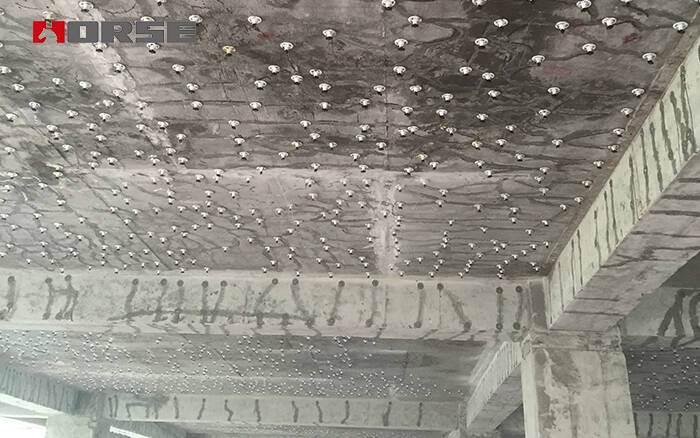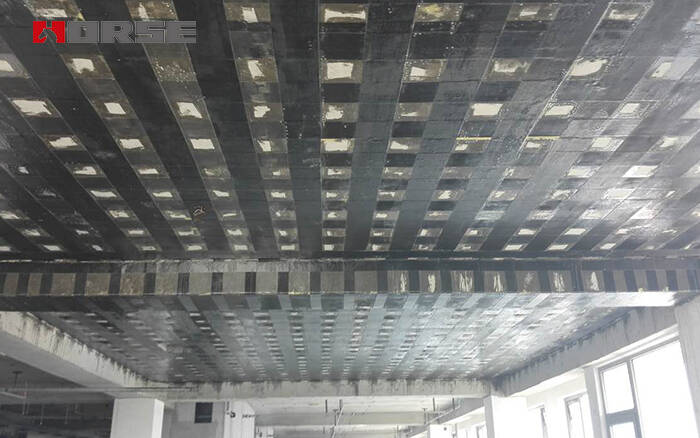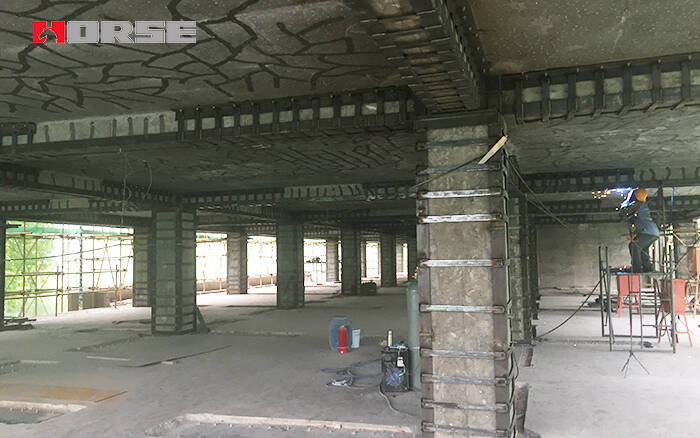Slab strengthening
slab strengthening with crack repair adhesive,CFRP wrap, steel plate
The concrete strength can't meet the design requirements, the crack width range is different, slab crack width exceeds the permissible value of standard 0.3 mm, therefore reinforcement measures for cracks taken.
Project overview
The Islamic Association of Ningxia building, in November 2, 2007 ,the pouring shaft eight layer roof, because the template support system is not stable, so that the section of concrete in the pouring collapsed. The seven layer is cracked. The concrete strength can't meet the design requirements, the crack width range is different, slab crack width exceeds the permissible value of standard 0.3 mm, therefore reinforcement measures for cracks taken.
The construction procedure
1.crack treatment:
1) clean the floating dust and other sundries in the fractured area, and can be constructed after a certain drying degree.
2) for cracks in slab width less than 0.3 mm, base after cleaning, evenly 2~3 modified epoxy resin structural reinforcing glue along the crack extension direction of liquid absorption, low viscosity and good permeability by capillary action in concrete surface, closed fracture channel.
3) for slab width between 0.3 ~ 1 mm static independent cracks, through the cracks of the base, after the treatment, the recoverable crack repair glue with certain pressure will be low viscosity and high strength crack injection, closed fracture channel.
4) for slabs width greater than 1 mm structure through cracks, in a certain period of time, with a high pressure grouting material will repair cracks with the indentation fracture cavity closed fracture channel.

(repair slab crack with HM-120L crack injection adhesive)
2.externally bonded carbon fiber reinfroced polymer(CFRP)
>>The treatment of concrete surface
The cosmetic layer, oil, dirt etc. Of concrete surface should be chiseled off and then rubbed off 1 ~2 mm thick surface layer with the
angle grinder, concrete components should be handled by chamfering on the corner, dust was blew out with compressed air after the
completion Of polishing, and finally the surface was wiped by cotton cloth dipped in acetone, and kept dry for use. If the concrete
needed to strengthen existed cracks, first choose HM-120M perfusion adhesive or HM-120L pouring crack adhesive to perfuse according
to the size of crack, and then strengthen.
>>Primer construction
When construction, two components of primer A and B were weighed according to the stipulated proportion of preparing glue, and
dumped into a clean container and stirred to uniformity (when mixing, best mix along the same direction to avoid the air from forming
air bubbles.) Brush or roller brush was used to evenly brush on the concrete surface, after the glue surface layer dried, it should be
brushed several times depending on the particular circumstances, but the coating thickness did not exceed 0.4 mm, and it should
not be missed out to brush, or have flowing or bubbles, waiting for glue curing (curing time was depended on the site temperature,
it was appropriate when finger felt dry, generally not less than 2 hours), then the next process was proceeded. The glue prepared
every time should be used up one time during the applicable period of the glue.
>>Leveling construction
The pores and defects on concrete surface were filled by leveling adhesive.When depression area was existed, the prepared leveling
adhesive was used to repair and fill through scraper embedding and scraping, the position emerging altitude difference such as the
joint of templates should be filled by leveling adhesive, which tried to minimize the height difference. The treatment of corner was that
it was repaired to smooth arc through leveling adhesive, its radius was not more than 20mm. After the leveling adhesive cured (curing
time was depended on the site temperature, it was appropriate when finger felt dry, generally not less than 2 hours), the next process
should be proceeded further.
>>Paste of carbon fiber cloth
Carbon fiber impregnated adhesive was smeared to the pasted area evenly,the corner site was more smeared appropriately. Paste after
hauling carbon fiber cloth tight and alignment, use a plastic scraper or roller (a paint roller that the villus was removed outside) to roll
repeatedly along the same direction, until the glue compound exuded. And then smear impregnated adhesive to the outside surface
of the carbon fiber cloth evenly, and roll repeatedly, 50 that the impregnated adhesive can immerse the carbon fiber cloth in two ways,
if it is multi-paste, until your fingers touch dry, the next layer of paste can be beginner. If the carbon fiber cloth needs overlapping
>>Curing and conservation
Prevent rain or moisture 24 hours after the completion of construction, and pay attention to protection against a hard Object bumping
into the surface of the construction. When the average air temperature is 20 , 25 ℃ , the curing time is not less than 3 days; when
the average air temperature is 10 ℃, the curing time is not less than 7 days.

(externally bonded carbon fiber reinfroced polymer(CFRP))
3.epoxy bonded steel plate
1.substrate surface clean
2.scribe line ro setting out
3.anchoring
4.plate surface preparing
5.bonding steel plate with the structural adhesive
6.maintaince
7.checking
8.protection coating

(slab strengthening with epoxy bonded steel plate)